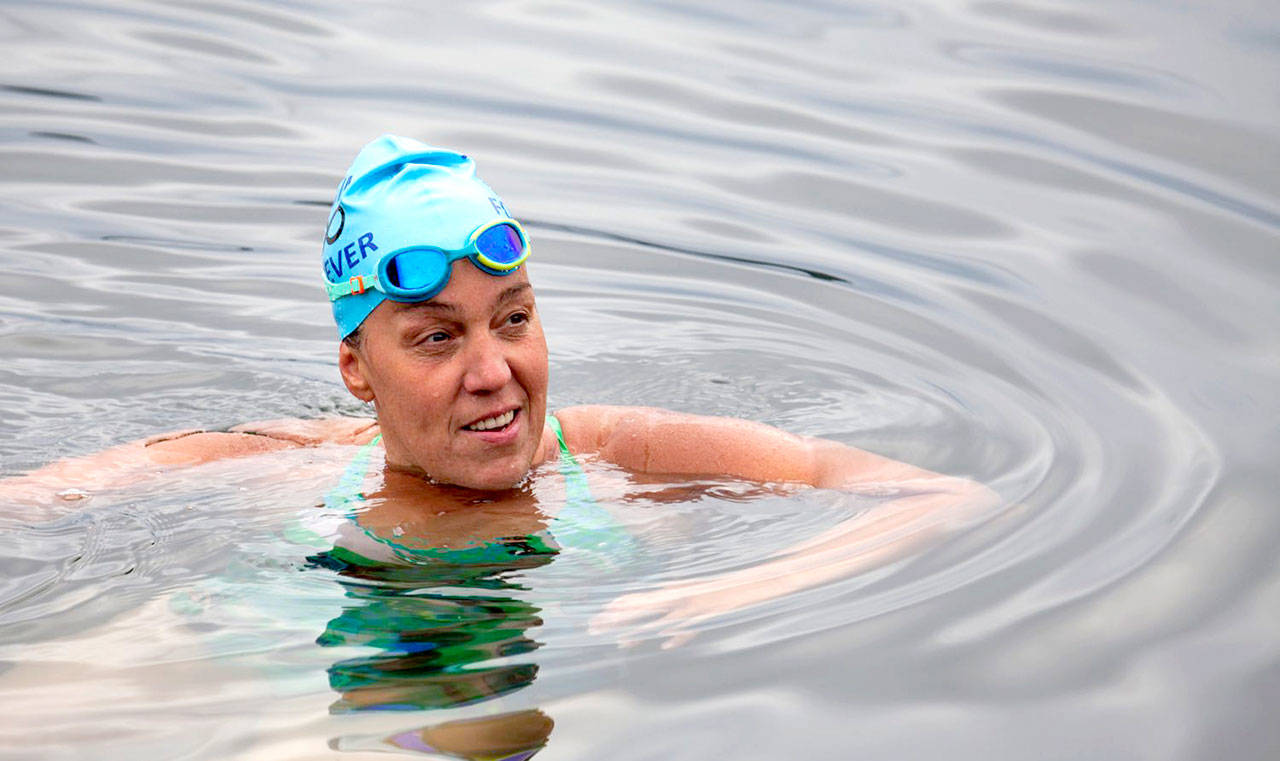By Paul Bucci
Special to Black Press Media
VICTORIA — When Susan Simmons steps off the beach for an epic attempt to swim across the Strait of Juan de Fuca from Victoria to Port Angeles and back, the feat will be as much about brains as it is about brawn.
She is planning to become the first person to cross the strait twice in the same swim on Wednesday, if the weather and tides permit. The date is weather dependent, and conditions must be exactly right if she is to have a chance at success — warm with very little wind and down-to-the-minute timing with the tides.
Simmons — ultra-marathon swimmer, coach, paddler and MS athlete —is a traditional swimmer, which means she wears nothing but a swimsuit, swim cap and goggles, and accepts no aid other than nourishment from her support crew.
Last year, she became the seventh swimmer to have ever crossed the Strait of Juan de Fuca from Port Angeles to Victoria without assistance of a wetsuit.
Simmons has spent hundreds of hours training for this event, along with her husband, Ray Este.
Training included nighttime swimming at Cowichan Lake where Simmons met her fear about swimming in blackness — that feeling of disorientation and nausea when the black water and sky meld into one.
“You can get pretty disoriented in the water and I tend to get really sick at night,” Simmons said later, discussing her training. “My stomach gets really upset because I lose my sense of where I am in the water.“
Simmons and Este figured out that the best place for him to shine a flashlight is just on her back, near her shoulder. By the time she moved to practicing night swims in the ocean, often off Oak Bay near Victoria, she was calmer about it.
“It’s actually quite beautiful and peaceful,” Simmons said. “I just follow my arms through the water.”
The swim will take at least 24 hours, which means Simmons will at some point be between the U.S. and Canada, swimming in the black of night, in the wild open waters of the Strait of Juan de Fuca.
You have to be tough-minded to be an ultra-marathon swimmer, and for Simmons, who battles multiple sclerosis, the war is both physical and psychological.
The training schedule was grueling: Weights twice a week, spin cycle twice a week, lake swims, pool swims, ocean swims — a minimum of 15 hours of swimming alone per week.
Behind the scenes, local sailor Gordon Higgins also has spent hundreds of hours on the quest; painstakingly planning the course, reading tide and current tables so that Simmons can use the power of the moon to help propel her to Washington state and back again.
“It’s called a neap tide,” Higgins said. “It’s one of the weakest tides of the year with the smallest difference between high-water and low-water.”
Higgins sounds very much like the computer scientist he is when reciting weather forecast stats off the top of his head.
“Long-range forecasts are 50 percent accurate,” he says. “Five-day forecasts are 80 percent accurate, and 48-hour forecasts are 95 percent accurate. It’s really all about the wind.”
And in the hours leading up to the decisive decision-making part of the swim, Simmons will bring herself to a place of peace.
“I listen to Ziggy Marley,” she said. “He sings about love and lifting ourselves up. These are things that are important to me.”
It’s about 20 miles as the crow flies from the small beach near the Ogden Point breakwater to Dungeness Spit near Port Angeles, but if Simmons left at the wrong time, she would be fighting a current most of the way and chances are she would never make it.
At 11 a.m., if conditions are right, Simmons will swim past the breakwater and aim for Race Rocks. At that point, about four hours later, she hopes to catch the tide change, and have the Pacific Ocean’s enormous flood tide push her to Dungeness Spit.
If she arrives successfully at Dungeness Spit before 11 p.m., she’ll then swim toward Royal Roads University, being pulled by the current back to Ogden Point.
“The plan is to have the tide behind her at all times, pushing her toward her objective,” Higgins said. “Timing is critical.”
Besides the incredible effort of swimming a minimum of 40 miles in open ocean, there are innumerable problems to solve and details to consider.
Higgins has rigged his boat — a Beneteau 34 called Synapse — with lights and spotlights, both to illuminate Simmons’ course throughout the night and to fend off other boats.
The Beneteau has a 30-horsepower engine, so Higgins will be constantly on the look-out for Simmons’ two safety boats, whales, deadheads, logs and crab traps, engaging and disengaging the engine.
Higgins will be in radio contact with U.S. and Canadian marine shipping authorities, warning freighters in the area to steer clear.
Simmons has permission from U.S. authorities to step out of the water up to her knees at Dungeness Spit. The rest of the 10 support crew do not. She’ll have only 10 minutes before she must depart again, if the plan works, at about 11 p.m., Higgins and the support crew carefully following in her wake.
“My support crew is my family,” Simmons said. “They are the people who really get me from shore to shore and truly do the most work. All – or most of – my crew are public servants. They all want to make the world a better place.”
_______
Black Press Media is the parent company of Sound Publishing, Inc., which owns the Peninsula Daily News.

